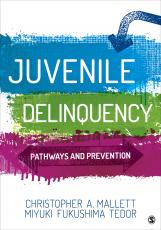Juvenile Delinquency: Pathways and Prevention
Juvenile Delinquency: Pathways and Prevention
Welcome to the SAGE edge site for Juvenile Delinquency, First Edition.
The SAGE edge site for Juvenile Delinquency by Christopher A. Mallett and Miyuki Fukushima Tedor offers a robust online environment you can access anytime, anywhere, and features an impressive array of free tools and resources to keep you on the cutting edge of your learning experience.

“This textbook is an excellent tool that explores issues impacting juvenile delinquency, theories, system response, community interventions, and effective programs to help reduce delinquency.”
—Robbin Day Brooks, MSW, CPP, Arizona State University’s School of Criminology & Criminal Justice
Juvenile Delinquency: Pathways and Prevention explores the pivotal roles that family, trauma, mental health, and schools have on juvenile delinquency, while exploring opportunities for prevention and intervention. Authors Christopher A. Mallett and Miyuki Fukushima Tedor draw from years of experience working with juvenile offenders to shed light on the nature of delinquency and the diverse pathways to juvenile delinquency, while offering evidence-based techniques for preventing and rehabilitating youthful offenders. Clear explanations of the concepts and thought-provoking case studies move students beyond memorization—encouraging them to think critically about juvenile delinquency and make recommendations for better practices and policies.
Give your students the SAGE edge!
SAGE edge offers a robust online environment featuring an impressive array of free tools and resources for review, study, and further exploration, keeping both instructors and students on the cutting edge of teaching and learning.
Acknowledgements
We gratefully acknowledge Christopher A. Mallett and Miyuki Fukushima Tedor for writing an excellent text and reviewing the materials on this site. Special thanks are also due to J.W. Carter II of Mount Saint Joseph University, Shelly McGrath of the University of Alabama at Birmingham, and Mari B. Pierce of Penn State University for developing the ancillaries on this site.
For instructors
Access resources that are only available to Faculty and Administrative Staff.
Want to explore the book further?

